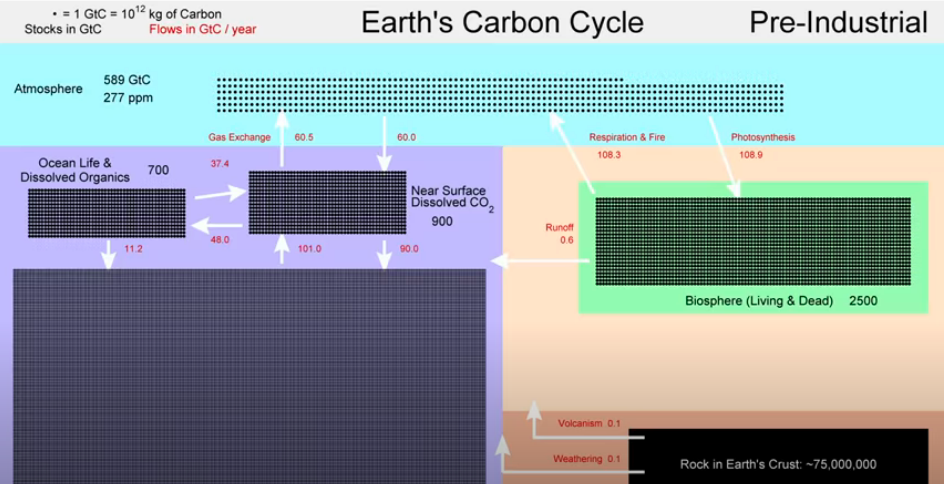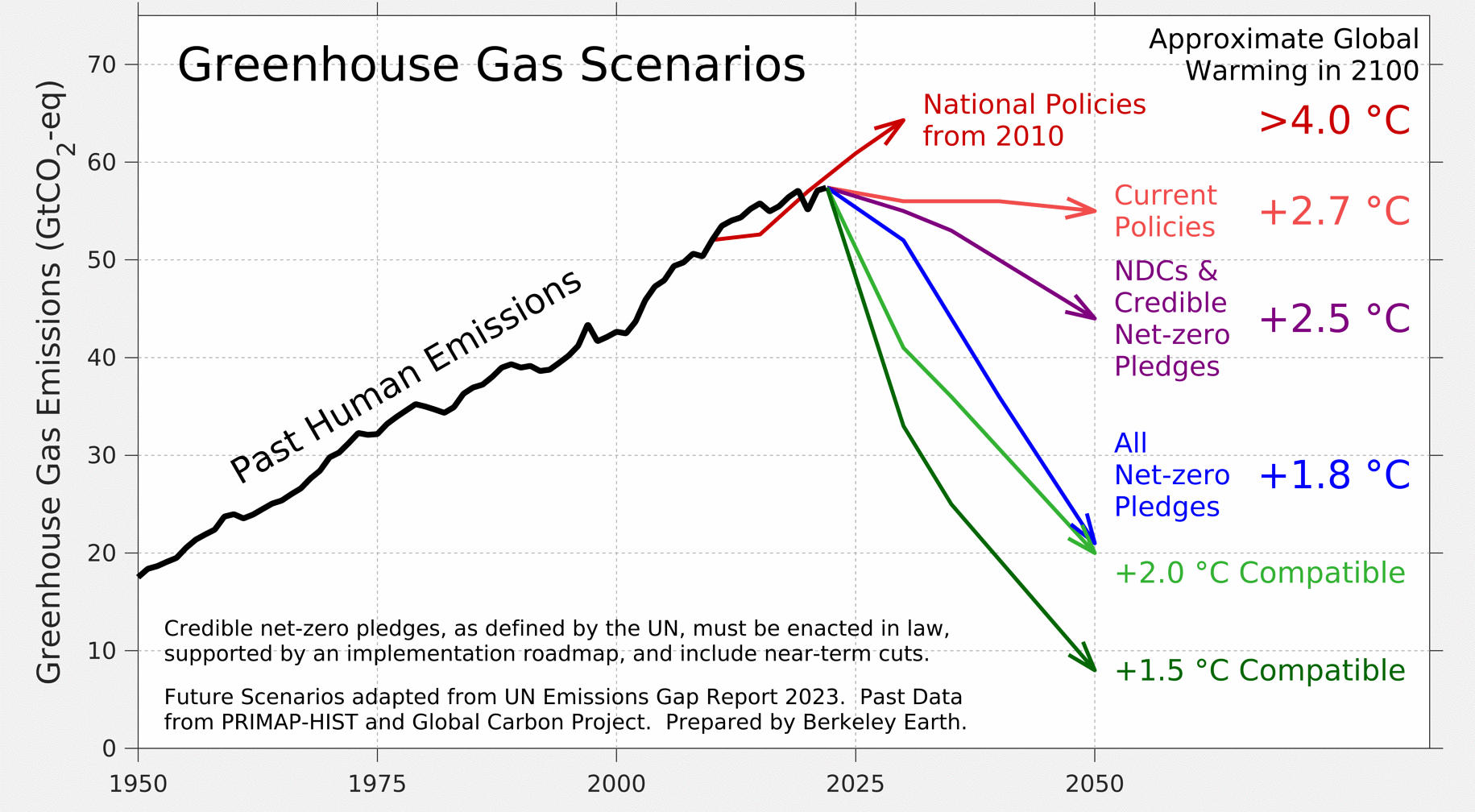

Actionable Climate Science forPolicymakers
2023 has been a year of climate superlatives: after five straight months (June – October) of record-breaking monthly average temperatures, it is nearly certain that the year will finish as the warmest on annual-average record. Additionally, Berkeley Earth’s analysis gives a 90% chance that 2023 will become the first year in our dataset to breach the 1.5°C threshold established by the Paris Agreement at COP21 in 2015. It is against this backdrop that COP28 takes place in Dubai.
In conjunction with the start of COP28, Berkeley Earth has updated our foundational, national-level projections with the most recent data available. Designed to be easily accessible to a variety of different stakeholders, these tools provide crucial climate insights including national-level projected warming trajectories based on IPCC emissions scenarios, decarbonization trends, and global progress towards meeting Paris Agreement targets. More information about Berkeley Earth’s climate data products is available on our Data Overview page.
// Country-Level Warming Projections
The world has warmed 1.3°C
How much has your country warmed?
The United Kingdom
Already +1.3 °C in 2022
Heading for around +1.3 °C in 2100
// National Carbon Trends
Global warming is caused by elevated levels of greenhouse gases in the atmosphere, with carbon dioxide and methane being the primary gases contributing to anthropogenic warming. To limit future warming, we must stop increasing the atmospheric concentration of carbon dioxide.
The figures below, updated with data through 2022, provide a snapshot of relative historic carbon emissions on a country-by-country basis, alongside data reflecting current progress towards reducing emissions and meeting net-zero targets.
The window is quickly closing to reduce emissions to the levels needed to limit warming to the 1.5°C target established by the Paris Agreement. According to the 2023 UN Emissions Gap Report, emissions need to fall by 28% by 2030 for the 2°C pathway, and 42% for the 1.5°C pathway. Despite the significant progress made recently in transitioning to low-carbon sources of energy, the IEA reports that the carbon intensity of the global energy sector reached a new record high of 37 billion tonnes of carbon dioxide in 2022, 1% higher than pre-pandemic averages. Nonetheless, the report notes that emissions levels are expected to peak this decade even in the absence of further policy commitments.
Carbon dioxide emissions originate from a wide range of human activities, including electricity generation, heating, agriculture, and transportation. Reducing total emissions to zero will require multiple strategies to address these different aspects of human activity, but ultimately require using both natural and technological alternatives, including carbon removal technology, to eliminate most uses of fossil fuels. This transformation of the world’s energy system will require substantial investments to operate at the scale required.
What is your country’s carbon trend?
| Carbon dioxide from Country Name | ||
|---|---|---|
| Annual carbon dioxide emissions |
40 tonnes per person | 25th highest,
2.5x world average |
| Trend in emissions (2010-2019) |
-1.0 tonnes per person per decade,
-10% per decade |
25th fastest decline |
| Net-zero with current trend |
2060 | 25th soonest |
| Cumulative emissions (1850-2020) |
250 million tonnes | 25th highest |
Rankings include subnational regions that are traditionally reported separately from their parent country, e.g. Greenland. Emissions reductions are expected to become more difficult as total emissions approach zero. Declining trends are unlikely to continue at the same pace without an increasing effort.
// Fossil Fuels and The Carbon Cycle
The only way to reduce temperatures is to reduce carbon.
The burning of fossil fuels – oil, coal, and natural gas – is the primary source of man-made atmospheric carbon dioxide. Since the start of the industrial revolution, humans have contributed more than 2,000 billion metric tons of carbon dioxide to the atmosphere.
After it is released into the atmosphere, the carbon dioxide is naturally redistributed between the atmosphere, the oceans, and the biosphere. However, none of the emitted carbon will return to the Earth by natural processes for many tens of thousands of years. As a result, the carbon that humans release by burning fossil fuels will lead to increased levels of carbon in the atmosphere, ocean, and biosphere for many thousands of years.
If carbon dioxide is allowed to continue to accumulate in the atmosphere, it will be impossible for the world to stay below 2.0°C, let alone 1.5°C.
// Global Emissions Commitments
Minding the Gap: Is 1.5°C Still Possible?
2023 will mark the UN’s first official global stocktake since the signing of the Paris Agreement in 2015, a comprehensive evaluation of progress towards the 1.5°C warming target that will help inform future discussions around national decarbonization commitments, or NDCs.
Over the past eight years, policy actions and transformations of energy systems have greatly reduced fossil fuel emissions, lowering the world’s future greenhouse gas emissions trajectory. The more severe warming scenarios projecting 4°-5°C of average warming now seem increasingly unlikely. However, despite this progress, current commitments and policies are insufficient for meeting the stated goals of the Paris Agreement.
The 2023 UN Emissions Gap Report finds that the projected increase in greenhouse gas emissions by 2030 has fallen from 16% at the time of the Paris Agreement in 2015, to an estimated 3% increase given policies in place today. This reduction is still far short of the 42% reduction in emissions needed to limit warming to 1.5°C, and the 28% reduction needed to remain below 2.0°C.
The lack of progress toward significant short-term emissions reductions has led some climate scientists to question whether the 1.5°C warming target is still realistic. Full implementation of current unconditional national pledges would limit temperatures to 2.9°C by 2100, nearly double the warming level set by the Paris Agreement, while full implementation of conditional pledges would lower that figure to only 2.5°C.
A recent article published in Nature Magazine cites that while the world’s tremendous progress towards low-carbon energy sources is an encouraging sign of progress towards meeting global warming targets, it notes that, by any measure, the transition towards low-carbon energy sources has still been too slow. And while financing for the energy transition has already accelerated significantly over the past few years, reaching $1.4 trillion in both private and public funding in 2022, this figure would need to rise to $9 trillion by 2030 to fund both the mitigation and adaptation efforts needed to respond to a warming climate.
After a scorching hot northern-hemisphere summer that witnessed five straight months of new record global average temperature, Berkeley Earth estimates a 90% chance that 2023 will be the first annual global average in our dataset to finish above the 1.5°C threshold. While the IPCC defines the 1.5°C target by the 30-year moving average, not a single year, breaching 1.5 °C this year would serve to emphasize how little time remains to meet this target.
While 2023 is likely to mark a significant milestone, a few months, or even a single year, warmer than 1.5 °C does not automatically mean that the goal has been exceeded. However, given current emissions rates, unless sharp reductions in man-made greenhouse gas emissions occur soon, the long-term global average is currently projected to pass 1.5 °C during the 2030s.
Berkeley Earth is an independent climate science non-profit, dedicated to providing high-quality, impartial climate data and analysis for decision makers at all levels. Our work was referenced in the 2021 IPCC Report on Climate Change, and has been featured extensively across major media outlets. For access to additional data about local warming trends, visit our regional temperature page.

Berkeley Earth is a 501c3 non-profit supported entirely by donations and charitable funding. If you found this information useful, make a contribution today.




